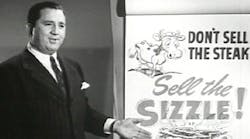At a recent association convention, I overheard two contractors discussing the growth of their companies. Each shared their annual revenue growth. I find this is not an exception but the norm. There is always an abundance of talk about revenue and number of trucks on the road but never much about pre-tax-profit (PTP). If a company grows from five trucks to 10, and the owner takes less to the bank or even the same amount, is this healthy growth?
A general rule of business is that low margin business tends to stay around year after year.
The growth of a contracting business usually takes place gradually. As a result, the owners and managers don’t realize the additional sleepless nights and anguish that more employees bring. The larger the organization, the more chances for things falling between the cracks. Management struggles to keep everyone working, especially during the off-season. As a result, they take on business that offers less gross margin. A general rule of business is that low margin business tends to stay around year after year.
When the decision is made to add another technician, the strategy should be to calculate how much revenue, gross margin and, most important, pre-tax-profit will result.
For the moment, let’s leave the personal and human elements aside. When the decision is made to add another technician, the strategy should be to calculate how much revenue, gross margin and, most important, pre-tax-profit will result. At the same time it is a prudent to calculate the ratio of profit to revenue. When a new truck, tool, or machine is added, competent managers will do so based upon the return on investment. Employees should be viewed the same. Albeit, it is a huge balancing act but it is always better to be one half a technician short than one half long. When a company is overstaffed, it is common to send techs on PM contracts beyond what was estimated. Naturally, this drives margins downward. Most technicians want to get at least their 40 hours in each week. When they see that the work force is on the heavy side, they tend to stretch out the time on PM calls. Again, this erodes the margin line.
I would much rather hear about double-digit profits rather than eight digit revenue streams.
When contractors grow exponentially, there’s less time to manage the customer base. The old 80/20 rule begins to apply: 20% of the customers provide 80% of the profits. I find very few managers/owners that are willing to glean the fields and fire some customers. When a customer is identified that is producing unacceptable gross margin percentage, or even negative margin, something needs to be addressed. If the problem stems from over extending the labor on PM agreements, management should re-estimate the contract at anniversary date or hold the labor to the estimated amount. There are only two things that will result from this and the contractor wins either way. The customer accepts the increase or the customer leaves.
Another management error is in not calculating ALL of the costs associated with adding a technician. It goes far beyond wages, benefits, trucks and tools. Every additional technician puts a stretch on every aspect of the organization. Additions require more management time as well as clerical and dispatch. Unfortunately, this again happens so gradually that it goes unnoticed until something breaks. Disgruntled personnel are usually the first manifestation. This leads to tasks being overlooked, and ultimately, loss of valuable employees. Eventually, a larger building is needed which makes a drastic impact on the overhead line. The additional taxes, maintenance, and insurance should be an integral part of every planning and forecasting procedure.
Therein lies the key: planning and forecasting. I was fortunate in my career that it began with a large control corporation. After four illustrious years in sales, I was rewarded (still questioning that one) with a management position. As a manager I was compelled to do a three-year plan each year. This task was so laborious that I locked myself in a hotel room for two weeks. At the time, I hated it but it paid huge dividends down the road. Most contractor/owners started with one truck and they drove it. In the early stages growth is rapid, not leaving time for much more than keeping the bills paid. When the business becomes a big machine, it can very easily spiral out of control.
All of this is not to say that growth is a bad thing. A controlled and planned growth is very desirable. When I’m listening in on a conversation at national conventions, I would much rather hear about double-digit profits rather than eight digit revenue streams.











